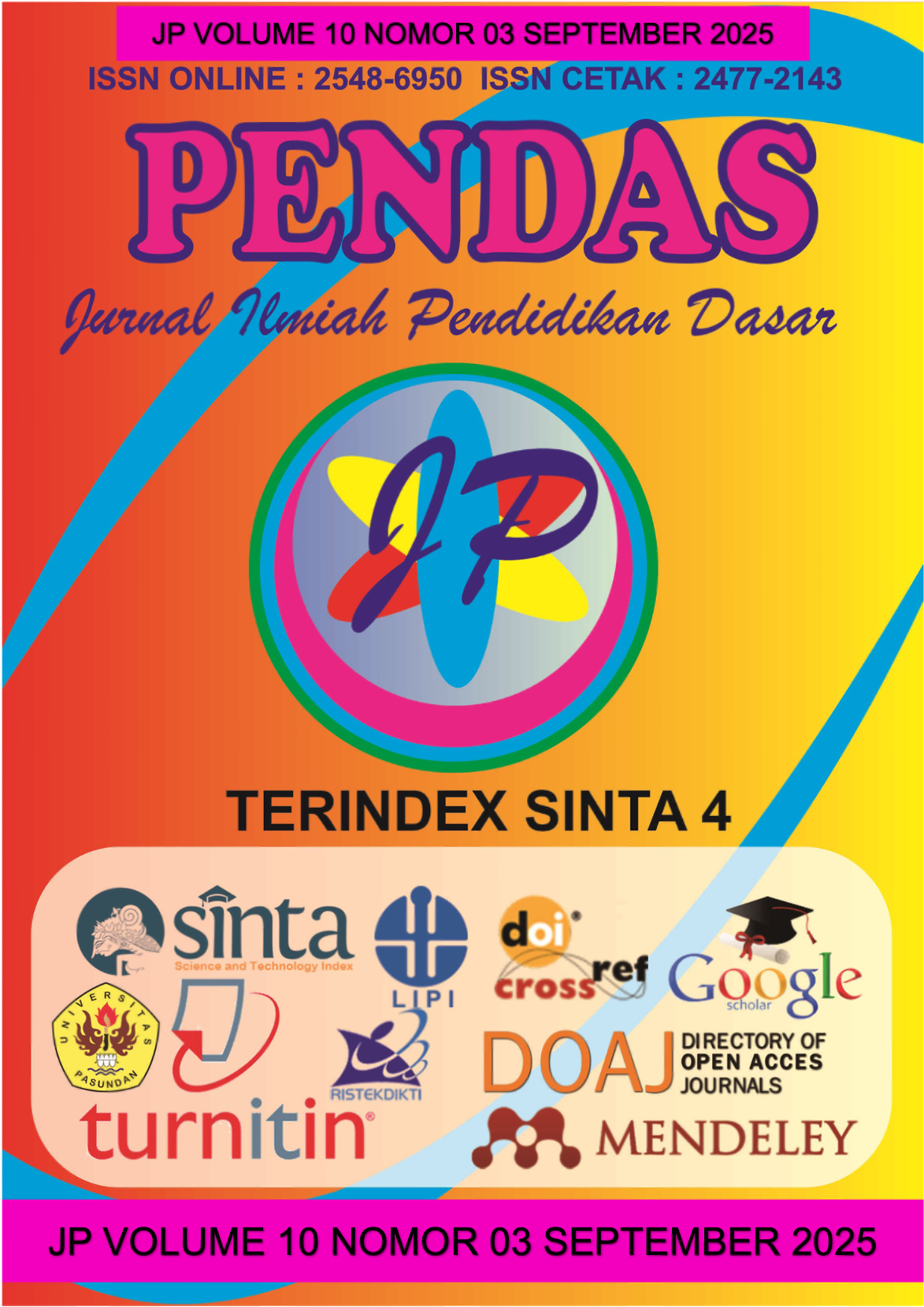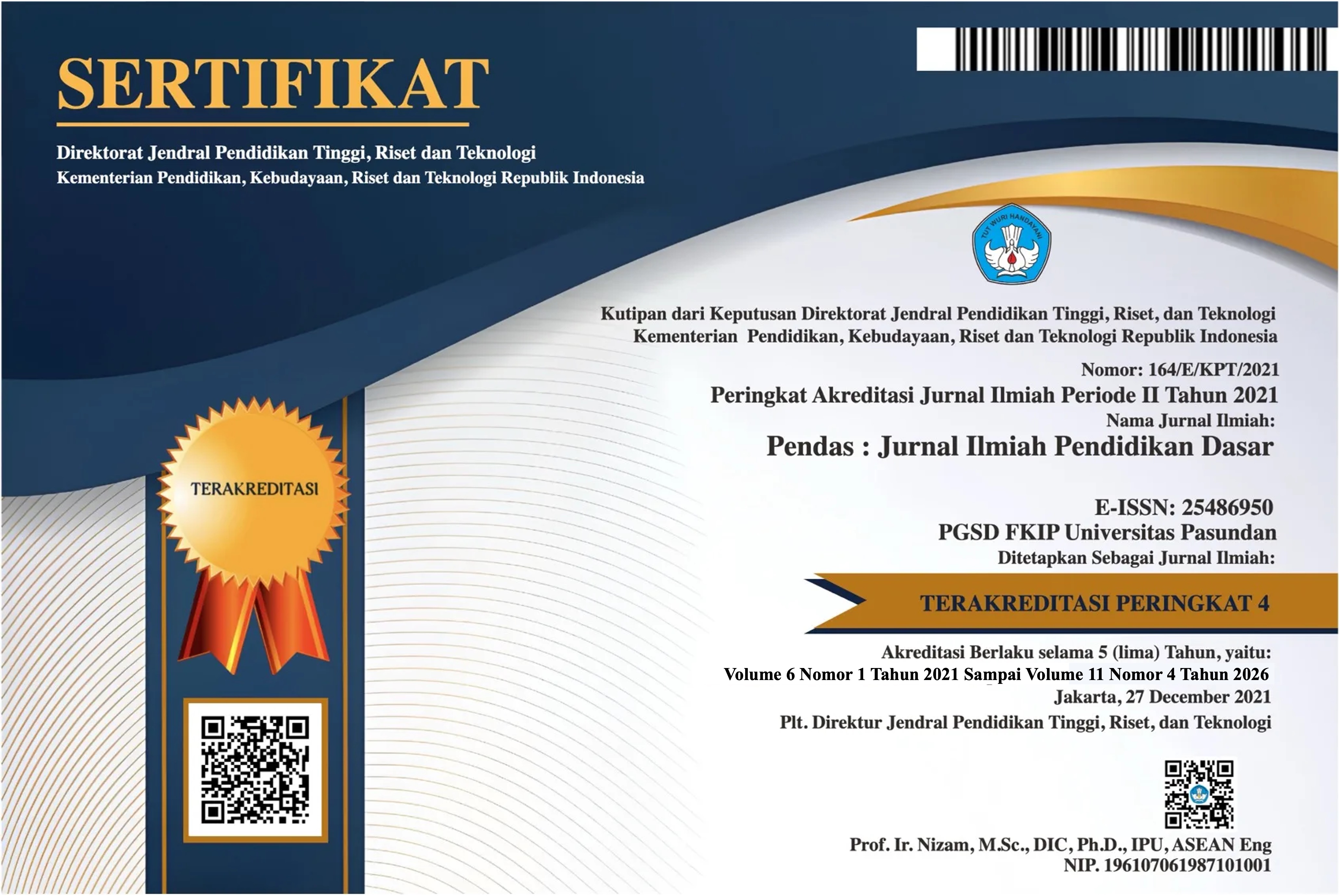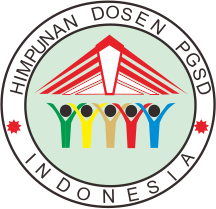BUDAYA BELAJAR MATEMATIKA RAMAH ANAK UNTUK PENGUATAN KECAKAPAN KOLABORASI DI SEKOLAH DASAR
DOI:
https://doi.org/10.23969/jp.v10i03.33772Keywords:
Collaboration, Mathematics, Learning, Child-FriendlyAbstract
Child-friendly mathematics learning is urgent in strengthening collaborative skills. A child-friendly approach encourages students to engage in deep conceptual communication. Collaboration has become increasingly important due to rapid global changes. This study aims to: 1) describe the culture of students learning with mathematics teachers, 2) describe the culture of students learning with peers in mathematics, and 3) explore the culture of students' independent learning in mathematics. This is a qualitative-ethnographic study conducted at Muhammadiyah Elementary School in Surakarta City, Central Java, from March to June 2025. The research data include both primary and secondary sources. Research subjects consist of the principal, teachers, and fifth-grade students at the research site. Data collection methods include interviews, observations, and document analysis. The researcher served as the key instrument. Data validity was ensured through source and method triangulation. Data were analyzed inductively. The findings reveal: 1) the implementation of child-friendly strategies by mathematics teachers has transformed the student learning culture with teachers to become more active, reflective, and collaborative, thereby strengthening collaboration; 2) an enjoyable learning culture was developed through child-friendly approaches to support collaboration enhancement. The success of collaboration heavily depends on the teacher as facilitator, the provision of challenging tasks, and process-based assessment; and 3) child-friendly mathematics learning promotes a culture of independent learning and supports collaboration. The role of teachers and professional support are critical to sustaining the transformation of the collaborative learning culture.
Downloads
References
Alzubi, A. A., Nazim, M., & Ahamad, J. (2024). Examining the effect of a collaborative learning intervention on EFL students’ English learning and social interaction. Journal of Pedagogical Research, 8(2), 26–46. https://doi.org/10.33902/JPR.202425541
Anchunda, H. Y., & Kaewurai, W. (2025). An instructional model development based on inquiry-based and problem-based approaches to enhance prospective teachers’ teamwork and collaborative problem-solving competence. Social Sciences and Humanities Open, 11(April), 101480. https://doi.org/10.1016/j.ssaho.2025.101480
Arslan, Z., Demirel, D., Çelik, D., & Güler, M. (2025). A study on how novice mathematics teachers respond to high-potential instances of student mathematical thinking. Thinking Skills and Creativity, 57, 101859. https://doi.org/https://doi.org/10.1016/j.tsc.2025.101859
Bakar, M. A. A., & Ismail, N. (2019). Metacognitive Learning Strategies in Mathematics Classroom Intervention: A Review of Implementation and Operational Design Aspect. International Electronic Journal of Mathematics Education, 15(1), 1–9. https://doi.org/10.29333/iejme/5937
Bhardwaj, V., Zhang, S., Tan, Y. Q., & Pandey, V. (2025). Redefining learning: student-centered strategies for academic and personal growth. Frontiers in Education, 10(February), 1–15. https://doi.org/10.3389/feduc.2025.1518602
Bicer, A., & Capraro, R. M. (2017). Longitudinal effects of technology integration and teacher professional development on students’ mathematics achievement. Eurasia Journal of Mathematics, Science and Technology Education, 13(3), 815–833. https://doi.org/10.12973/eurasia.2017.00645a
Bognar, B., Mužar Horvat, S., & Jukić Matić, L. (2025). Characteristics of Effective Elementary Mathematics Instruction: A Scoping Review of Experimental Studies. Education Sciences, 15(1), 1–38. https://doi.org/10.3390/educsci15010076
Burns, S., Yu, E., Brathwaite, L., Masum, M., White, L., Dhuey, E., & Perlman, M. (2024). Improving young children’s peer collaboration in early educational settings: A systematic review. Review of Education, 12(2), 1–34. https://doi.org/10.1002/rev3.3484
Chu, M., Fang, Z., Mao, L., Ma, H., Lee, C. Y., & Chiang, Y. C. (2024). Creating A child-friendly social environment for fewer conduct problems and more prosocial behaviors among children: A LASSO regression approach. Acta Psychologica, 244(September 2023), 104200. https://doi.org/10.1016/j.actpsy.2024.104200
Creswell, J. (2012). Creswell (2013) Qualitative Research Narrative Structure.pdf. In Qualitative Inquiry and Research Design: Choosing Among Five Approaches, Third Edition.
Darling-Hammond, L., Flook, L., Cook-Harvey, C., Barron, B., & Osher, D. (2020). Implications for educational practice of the science of learning and development. Applied Developmental Science, 24(2), 97–140. https://doi.org/10.1080/10888691.2018.1537791
Fitriani, S., Istaryatiningtias, & Qodariah, L. (2021). A child-friendly school: How the school implements the model. International Journal of Evaluation and Research in Education, 10(1), 273–284. https://doi.org/10.11591/IJERE.V10I1.20765
Golden, B. (2023). Enabling critical thinking development in higher education through the use of a structured planning tool. Irish Educational Studies, 42(4), 949–969. https://doi.org/10.1080/03323315.2023.2258497
Henriksen, D., Henderson, M., Creely, E., Carvalho, A. A., Cernochova, M., Dash, D., Davis, T., & Mishra, P. (2021). Creativity and risk-taking in teaching and learning settings: Insights from six international narratives. International Journal of Educational Research Open, 2, 100024. https://doi.org/https://doi.org/10.1016/j.ijedro.2020.100024
Herner-Patnode, L., & Lee, H. J. (2021). Differentiated instruction to teach mathematics: Through the lens of responsive teaching. Mathematics Teacher Education and Development, 23(3), 6–25.
Hidayat, M., Agusta, R., A. (2025). Inovasi Model Pembelajaran Pantun: Upaya Meningkatkan Keterampilan Berpikir Kritis, Kerjasama Dan Tanggung Jawab Siswa Sekolah Dasar. Jurnal Ilmiah Pendidikan Dasar, 10(03), 185.
Kim, J., Lee, H., & Cho, Y. H. (2022). Learning design to support student-AI collaboration: perspectives of leading teachers for AI in education. In Education and Information Technologies (Vol. 27, Issue 5). Springer US. https://doi.org/10.1007/s10639-021-10831-6
Krisdiawan, R. A., & Ramdhany, T. (2018). Implementasi Algoritma Fisher Yates Pada Games Edukasi Pengenalan Hewan Untuk Anak Sd Berbasis Mobile Android. Jurnal LPKIA, 11(2), 123–254.
Leal Filho, W., Raath, S., Lazzarini, B., Vargas, V. R., de Souza, L., Anholon, R., Quelhas, O. L. G., Haddad, R., Klavins, M., & Orlovic, V. L. (2018). The role of transformation in learning and education for sustainability. Journal of Cleaner Production, 199, 286–295. https://doi.org/10.1016/j.jclepro.2018.07.017
Li, H. (2025). Impact of collaborative learning on student engagement in college English programs: mediating effect of peer support and moderating role of group size. Frontiers in Psychology, 16(April), 1–11. https://doi.org/10.3389/fpsyg.2025.1525192
Liestyasari, S. I., Karsidi, R., Asrowi, & Rahman, A. (2023). Challenges of implementing child-friendly school model in Surakarta, Indonesia. International Journal of Evaluation and Research in Education, 12(4), 2130–2137. https://doi.org/10.11591/ijere.v12i4.25149
Markula, A., & Aksela, M. (2022). The key characteristics of project-based learning: how teachers implement projects in K-12 science education. Disciplinary and Interdisciplinary Science Education Research, 4(1). https://doi.org/10.1186/s43031-021-00042-x
Muhamad Fadzil, N., & Osman, S. (2025). Scoping the landscape: Comparative review of collaborative learning methods in mathematical problem-solving pedagogy. International Electronic Journal of Mathematics Education , 20(2). https://doi.org/10.29333/iejme/15935
Olsen, R. K. (2025). The Value of Child Participation in Research—A Qualitative Child-Centered Approach to the Early Development of an Empowerment Inventory for Children. Child and Youth Services, 46(2), 400–421. https://doi.org/10.1080/0145935X.2024.2336914
Rehman, N., Huang, X., Mahmood, A., AlGerafi, M. A. M., & Javed, S. (2024). Project-based learning as a catalyst for 21st-Century skills and student engagement in the math classroom. Heliyon, 10(23), e39988. https://doi.org/10.1016/j.heliyon.2024.e39988
Sachdeva, S., & Eggen, P.-O. (2021). Learners’ Critical Thinking About Learning Mathematics. International Electronic Journal of Mathematics Education, 16(3), em0644. https://doi.org/10.29333/iejme/11003
Scott-Barrett, J., Johnston, S.-K., Denton-Calabrese, T., McGrane, J. A., & Hopfenbeck, T. N. (2023). Nurturing curiosity and creativity in primary school classrooms. Teaching and Teacher Education, 135, 104356. https://doi.org/https://doi.org/10.1016/j.tate.2023.104356
Siller, H. S., & Ahmad, S. (2024). Analyzing the impact of collaborative learning approach on grade six students’ mathematics achievement and attitude towards mathemat. Eurasia Journal of Mathematics, Science and Technology Education, 20(2). https://doi.org/10.29333/ejmste/14153
Simacek, J. J., Riegelman, A., Gunderson, J., Worthley, E., Dimian, A. F., Chaxiong, P., & Wolff, J. J. (2025). Examining Behavioral Interventions for Infancy and Early Toddlerhood: A Systematic Review of Intervention Effects, Parameters, and Participants. In Journal of Autism and Developmental Disorders (Issue 0123456789). Springer US. https://doi.org/10.1007/s10803-025-06804-0
Sutama, S. (2019). Metode penelitian pendidikan kuantitatif, kualitatif, PTK, mix method, R & D. CV Jasmine. Kartasura. Sukoharjo.
Thanheiser, E., & Melhuish, K. (2023). Teaching routines and student-centered mathematics instruction: The essential role of conferring to understand student thinking and reasoning. Journal of Mathematical Behavior, 70(December 2022), 101032. https://doi.org/10.1016/j.jmathb.2023.101032
Thornhill-Miller, B., Camarda, A., Mercier, M., Burkhardt, J. M., Morisseau, T., Bourgeois-Bougrine, S., Vinchon, F., El Hayek, S., Augereau-Landais, M., Mourey, F., Feybesse, C., Sundquist, D., & Lubart, T. (2023). Creativity, Critical Thinking, Communication, and Collaboration: Assessment, Certification, and Promotion of 21st Century Skills for the Future of Work and Education. Journal of Intelligence, 11(3). https://doi.org/10.3390/jintelligence11030054
Tobin, B., Farren, M., & Crotty, Y. (2024). Impacting teaching and learning through collaborative reflective practice. Educational Action Research, 1(2), 1–21. https://doi.org/10.1080/09650792.2024.2394933
Tong, D. H., Uyen, B. P., & Quoc, N. V. A. (2021). The improvement of 10th students’ mathematical communication skills through learning ellipse topics. Heliyon, 7(11), e08282. https://doi.org/10.1016/j.heliyon.2021.e08282
Treve, M. (2024). Comparative analysis of teacher-centered and student-centered learning in the context of higher education: A co-word analysis. Iberoamerican Journal of Science Measurement and Communication, 4(2), 1–12. https://doi.org/10.47909/ijsmc.117
Woods, P. J., & Copur-Gencturk, Y. (2024). Examining the role of student-centered versus teacher-centered pedagogical approaches to self-directed learning through teaching. Teaching and Teacher Education, 138, 104415. https://doi.org/https://doi.org/10.1016/j.tate.2023.104415
Downloads
Published
Issue
Section
License
Copyright (c) 2025 Pendas : Jurnal Ilmiah Pendidikan Dasar

This work is licensed under a Creative Commons Attribution 4.0 International License.



















